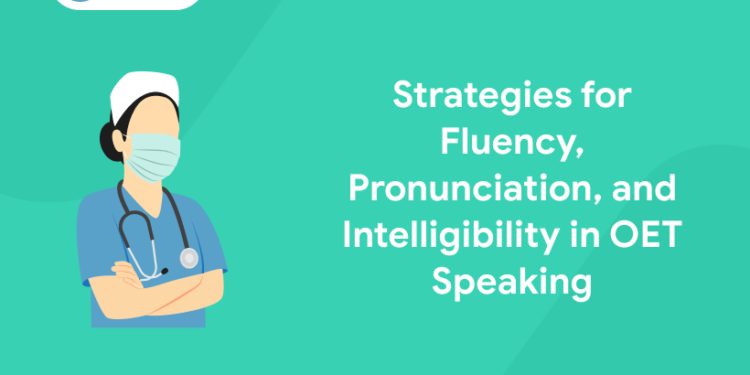Table of Contents
The Occupational English Test (OET) is a language test for healthcare professionals interested in working or studying in an English-speaking setting. Four skills are evaluated on the test: speaking, reading, writing, and listening. Here, we’ll concentrate on the speaking portion of the test and discuss some tips and tricks for acing it.
What is the OET speaking subtest
In the OET speaking subtest, a candidate converses one-on-one with an interlocutor who assumes the persona of a patient, client, or patient’s relative or carer. The subtest comprises of two role-plays that are unique to the profession and lasts roughly 20 minutes. If you’re a nurse, you might need to reassure a patient, offer advise, or explain a procedure. The role-plays are based on real-world working situations that people may come into in their line of work.
The Interlocutor will provide the candidate with a card (cue card) containing information about the role-play, such as the setting, purpose, and points to cover. Each role-play will give candidates three minutes to get ready. You may make notes on the card, but you are not permitted to use any additional materials. The applicant will next strike up a dialogue with the interlocutor in an effort to fulfil the role-play’s objectives. The interlocutor will adhere to a script and give appropriate answers. The length of each role-play is between five and six minutes.
Get your Desired OET Scores in Weeks! Get Free Demo Class Here!
How is the OET speaking subtest assessed
1: What is the primary purpose of a patient’s discharge summary?
The OET speaking subtest is graded by two professional examiners who listen to a recording of the performance. They use a set of standards to evaluate performance on nine different fronts, including relationship-building, understanding and incorporating the patient’s perspective, providing structure, fluency, appropriateness of language, resources of grammar, and information gathering.
Each component is given a score, and the scores are averaged to produce an overall rating for each role-play. The two role-play scores combine to form the subtest’s overall score.
Acing the OET Speaking Subtest: Tips and Strategies
Many OET applicants are proficient in English grammar. But when it comes to speaking, they are speechless. This is a typical issue. Numerous contenders deal with this problem. They might be able to do well on other subtests like Reading, Listening, and even Writing, but the Speaking subtest puts a roadblock in their path.
The only solution to this issue is to develop your speaking abilities. The best method for improving fluency is to listen a lot. A lot of practise is necessary.
Keep in mind that speaking is built on listening. Take in a lot of medical information. You’ll speak more effectively as a result of this. You might wonder why there is medical stuff. The straightforward explanation is that your OET will include medical information.
Practicing with a partner
Finding someone who can assist you in honing your skills is usually a smart idea. There must be one such individual in your neighbourhood or among your acquaintances. Or a member of your family can offer you a lot of assistance. You can also choose to join one of the nearby clubs or organisations, where you can make some new friends. You’ll get better at communicating with them in English if you do.
Learning from mistakes
Everyone makes errors. You might find it challenging to express yourself in English as you learn. You will gradually witness an improvement in your abilities. You’ll start sounding considerably better when you speak. with decent fluidity. Keep in mind that learning is a lifelong process. You can keep honing your English-speaking abilities.
Listen and speak
It’s necessary to listen to as much English-language content as you can while practising. There are many audio books available, as well as websites that will read the information to you. (or software programmes that read the information for you). You can get a sense of how to speak by watching videos on YouTube. To fully understand such speaking abilities, pay close attention while listening appropriately.
You could be unable to accurately assess your own speaking abilities. Take assistance from a person who can evaluate your speaking abilities fairly. It doesn’t contain anything depressing. After considering the criticism, you might concentrate on your weaknesses.
Get your Desired OET Scores in Weeks! Get Free Demo Class Here!
Relearn grammar – focus on healthcare content
As a healthcare professional, you must be fluent in both everyday English and medical English. You must utilise plain English while speaking with patients. You will need to concentrate on medical English for all of your communications with your colleagues in the medical field and for a variety of additional purposes. Online, there are a tonne of books that instruct in medical English. To learn more about grammar and begin using the concepts at work, you can purchase one of those books.
Use Discourse-Markers
Understanding how to effectively employ common speech expressions is a key aspect of displaying fluency. Discourse markers are crucial and helpful in speaking because they enable us to link, arrange, and control what we say while also expressing our attitudes towards a certain concept or course of action. Discourse markers increase fluency by enhancing the clarity, naturalness, and accessibility of our speech to the listener.
Take Control Of The Pause
Speaking clearly requires knowing when to pause, which is different from never pausing. There will be times when pausing makes sense to underline a particularly crucial piece of information or to give your listener time to process certain information. A listener can quickly distinguish between an ineffective pause—like the one in the toilet earlier—and an intentional pause intended to advance communication. Your use of the latter will be more effective the less of the former you perform.
Get your Desired OET Scores in Weeks! Get Free Demo Class Here!
How are you scored in OET Speaking?
At least two certified OET assessors record and score your role plays. They use linguistic and clinical communication criteria to evaluate your speaking performance. This blog provides an overview of each criterion so you may quickly understand how your speaking abilities are evaluated.
Linguistic Criteria
Intelligibility
This entails speaking properly enough for people to comprehend you. You need to speak with the appropriate tone of voice, clearly pronounce words and sounds, and punctuate and rhythmically pace your sentences. Consider that you are educating a patient about a novel drug. In order for the patient to understand, you must pronounce the medication’s name correctly, use the appropriate tone of voice, and emphasise key terms like dosage and timing.
Fluency
This involves speaking smoothly and at the appropriate rate. Speaking should not be done at an accelerated or slowed rate, nor should it be done with excessive pauses or hesitation. Consider a situation when you had to inform a patient of unpleasant news. Speaking slowly and fluidly, you would pause when necessary to allow the patient to process the information.
Appropriateness of language
This criterion takes into account how you employ the appropriate language and tone for the circumstance and the patient. When describing medical processes or symptoms, use language that a non-medical person can comprehend. For example, you wouldn’t use medical language when discussing a complicated process to a patient. Instead, you would speak to the patient in plain, everyday terms.
Resources of grammar and expression
This includes correctly applying a variety of words and grammar. Your ability to communicate your views effectively and without ambiguity is required.
Get your Desired OET Scores in Weeks! Get Free Demo Class Here!
Clinical Communication Criteria
Relationship building
This involves greeting the patient with courtesy and respect, paying close attention to what they have to say, refraining from passing judgement, and demonstrating understanding of their circumstances and feelings.
Understanding & incorporating the patient’s perspective
This involves learning about and comprehending the patient’s ideas, concerns, and hopes. Additionally, you need to react to the patient’s cues or alterations in behaviour. For instance, if a patient is anxious about a treatment, you would first ask about their worries and expectations before addressing them in your explanation of the operation.
Providing structure
This entails adopting ways to make your explanations orderly and obvious, logically structuring the discourse, and making it plain when you switch topics.
Information gathering
This means paying close attention to the patient’s account, asking open questions initially, followed by more detailed inquiries, refraining from using ambiguous or condescending language, requesting additional information when necessary, and summarising the data to ensure comprehension. Consider a patient who presents with the general complaint, “I just don’t feel well.” You would ask open-ended inquiries to elicit more details, and then more focused questions to hone in on the likely causes.
Information giving
Finding out what the patient already knows, pausing while delivering information to ensure understanding, allowing the patient to express their responses or feelings, confirming the patient has grasped the information, and determining what additional information the patient needs are all part of this process. Imagine explaining the test results to a patient. You would first ask them what they already know, then proceed to explain the results, pausing to ensure that they understood and to address any concerns they may have.
Conclusion
You’ll do better on the OET Speaking sub-test if you are aware of these requirements. But more crucially, these abilities will improve your performance as a healthcare provider. They will support you in understanding your patients’ requirements and expressing them in a clear manner. When you relocate to an English-speaking nation, this will help you become a safer and more productive healthcare professional.
Strategies for Fluency, Pronunciation, and Intelligibility in OET Speaking: FAQs
Q1. What is the structure of the OET speaking test?
Ans: There are two tasks in the Speaking section of the Occupational English Test. Candidates participate in a role-playing scenario for each activity that is intended to simulate patient interactions that healthcare professionals frequently deal with. Usually, this phase lasts for 20 minutes.
Q2. How long is the OET Speaking exam?
Ans: The written tests will last for about three hours, and the speaking test will last for 20 minutes. To complete the test, you must be available for a full day.
Q3. What happens if I miss my OET speaking test?
Ans: If you are unable to take your scheduled test, you may postpone it to a different date, location, or test type, subject to the terms and fees.
Q4. OET speaking preparation time?
Ans: For each question, you will have three minutes to prepare and five minutes to act out the role play. In total, there will be 2 questions, which will take about 16 minutes to complete [3 minutes for preparation + 5 minutes for the role play multiplied by 2 role plays].
Q5. What is the speaking format for OET?
Ans: The OET’s speaking subtest consists of one activity that is split into two distinct role-plays. You will play the role of a health professional, and your interlocutor will play a patient or patient care provider in the role-plays.
Get your Desired OET Scores in Weeks! Get Free Demo Class Here!
| Related Links | |
| OET Speaking Topics | OET Writing – Complete Guide |
| OET Speaking – Complete Guide | OET Reading Samples |
| OET vs IELTS | OET Reading Tips |











